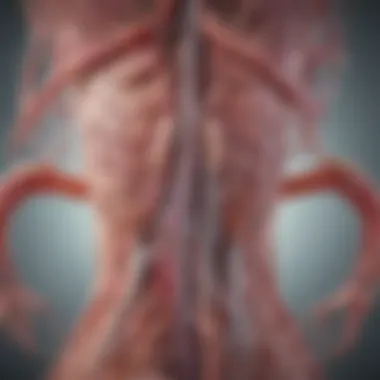Understanding Sensitivity to DHT: Mechanisms & Implications


Intro
Sensitivity to dihydrotestosterone (DHT) is a complex biological phenomenon. Understanding its implications is crucial for comprehending various medical conditions, notably those related to hair loss and prostate health. DHT is an androgen, a type of hormone that plays a vital role in male development and health. However, individual responses to this hormone can vary significantly. This variability arises from several interplaying factors, including genetics, hormonal pathways, and environmental influences.
This article will delve into the intricacies of DHT sensitivity, elucidating its mechanisms and implications. We aim to answer essential questions: What determines DHT sensitivity? How does it affect conditions such as androgenetic alopecia and benign prostatic hyperplasia? And what does current research suggest about future therapies and interventions?
Key Concepts
Definition of Primary Terms
Dihydrotestosterone (DHT): A potent androgen derived from testosterone. It is responsible for the development of male characteristics and has significant roles in hair follicle regulation and prostate function.
Sensitivity: The degree to which an individual's biological systems respond to specific hormones or stimuli. In the context of DHT, it refers to how effectively DHT interacts with target tissues.
Androgenetic Alopecia: A common form of hair loss in both men and women, influenced by genetic and hormonal factors, often linked to sensitivity to DHT.
Benign Prostatic Hyperplasia (BPH): A condition characterized by the enlargement of the prostate gland, which can be influenced by DHT levels and sensitivity.
Related Concepts and Theories
- Hormonal Pathways: The processes through which hormones, including DHT, exert their effects. Understanding these pathways is essential for comprehending sensitivity.
- Genetic Factors: Genetic predispositions can affect how individuals process and respond to DHT, influencing susceptibility to conditions like hair loss and prostate issues.
- Environmental Factors: Lifestyle choices, diet, and exposure to certain substances can modulate hormone sensitivity, including DHT response.
"Understanding the sensitivity to DHT is not just about hormones; it's about the interplay of various biological, genetic, and environmental factors."
Future Directions
Gaps Identified in Current Research
While significant insights have been gained concerning DHT sensitivity, several knowledge gaps persist. More research is needed to explore:
- The specific genetic markers that predispose individuals to heightened or reduced sensitivity.
- The role of environmental factors in modifying the effects of DHT.
- Long-term outcomes of therapies aimed at modulating DHT sensitivity.
Suggestions for Further Studies
- Conduct longitudinal studies to assess how DHT sensitivity changes with age and in response to treatments.
- Investigate the molecular mechanisms that underlie the development of androgenetic alopecia and BPH in relation to DHT sensitivity.
- Explore potential therapeutic interventions targeting DHT pathways to enhance treatment efficacy.
In summary, a thorough understanding of DHT sensitivity is essential for addressing related health issues. Ongoing investigation in this field will likely reveal new therapeutic possibilities and broaden our understanding of hormonal interactions.
Prelims to DHT Sensitivity
Dihydrotestosterone, commonly referred to as DHT, plays a pivotal role in various biological processes within the human body. Regarding sensitivity to DHT, its significance is multifaceted, covering areas from hormonal balance to implications for specific health conditions. Understanding this sensitivity is vital for grasping how hormonal fluctuations contribute to health issues such as hair loss and prostatic problems. Here, we will delve into its definition, the hormonal landscape it interacts with, and its necessity in human biology.
Definition of DHT
DHT is an androgen, a term for male hormones, that is derived from testosterone through the action of the enzyme 5-alpha reductase. The characterization of DHT is essential when discussing its effects on the body. It has a stronger affinity for androgen receptors than testosterone, allowing it to exert more potent effects in target tissues. This potency underlies the importance of understanding DHT sensitivity, as variations in how the body responds to DHT can lead to various health outcomes.
Overview of Hormonal Function
Hormones serve as regulatory molecules, orchestrating numerous physiological processes throughout the body. DHT, being an androgen, is integral in the development of male characteristics, influencing the growth of body hair, skin health, and prostate function. DHT also plays a crucial part in sexual health, contributing to libido and erectile function. In women, DHT is present but in lower levels and is involved in functions like follicular development and sexual health. As one examines DHT sensitivity, it is important to acknowledge how hormonal function is interconnected within various systems, illustrating the broader implications of this sensitivity in different populations.
Importance of DHT in Human Biology
The role of DHT in human biology cannot be understated. It is intricately involved in both the development of male phenotypes during puberty and the maintenance of several physiological functions in adulthood. Moreover, alterations in sensitivity to DHT can lead to conditions such as androgenetic alopecia, which affects millions globally, and benign prostatic hyperplasia, leading to urinary complications.
Research indicates that genetic predisposition and environmental factors significantly influence how individuals respond to DHT, establishing a complex relationship that warrants detailed studies.
In summary, understanding DHT sensitivity opens avenues for exploring the underlying mechanisms that lead to varying health conditions. This knowledge is crucial for tailoring therapeutic interventions and advancing the field of endocrinology.
Mechanisms of DHT Sensitivity
Understanding the mechanisms of sensitivity to dihydrotestosterone (DHT) is crucial as it provides insight into how DHT influences various biological functions and medical conditions. DHT is a potent androgen that binds to specific receptors in the body, eliciting a wide range of physiological responses. The interplay between genetic, environmental, and hormonal factors impacts overall sensitivity to DHT, which can have significant implications for conditions such as androgenetic alopecia and benign prostatic hyperplasia.
Androgen Receptor Interaction


DHT exerts its effects primarily through androgen receptors (AR) located in various tissues, including the skin and the prostate. The interaction between DHT and its receptors initiates a cascade of cellular events that can influence hair growth, development of male sexual characteristics, and prostate function. Sensitivity levels can vary widely among individuals, largely depending on how effectively DHT ligands like DHT bind to these receptors. A heightened sensitivity may lead to increased expression of AR-mediated genes, potentially resulting in unwanted physiological changes, such as hair loss, in susceptible individuals.
Genetic Factors Influencing Sensitivity
Genetics plays a significant role in determining an individual's sensitivity to DHT. Various polymorphisms in the androgen receptor gene can affect how the body responds to androgens.
Role of AR gene polymorphisms
AR gene polymorphisms are variations in the DNA sequence within the androgen receptor gene that can significantly affect receptor functionality. These polymorphisms may influence the receptor's affinity for DHT, thereby modifying the body's responsiveness to androgens. This aspect is crucial for understanding gender-specific differences in conditions like androgenetic alopecia.
A key characteristic of these polymorphisms is their prevalence among different populations, which highlights the genetic diversity in sensitivity to DHT. This diversity ultimately offers valuable insights when studying patients with testosterone-related health issues. However, interpreting the impact of these polymorphisms is complex, as they can contribute to both increased risk of conditions like hair loss, and potentially protective mechanisms in other cases.
Influence of inherited traits
Inherited traits also contribute to how individuals process DHT. Family histories of conditions such as prostate hyperplasia can indicate a genetic predisposition to heightened or diminished sensitivity to DHT, suggesting that examining family health background is essential in risk assessments.
A key characteristic of inherited traits is their ability to reveal patterns that genetic testing alone may not elucidate. Families with a history of certain conditions may share genetic markers that predispose them to heightened sensitivity to hormonal influences. While this genetic insight is fundamental to understanding specific cases, it can present challenges. Individuals may exhibit varying degrees of sensitivity based on multiple inherited traits, making precise predictions difficult.
Environmental Influences
Environmental factors can modulate how our bodies react to DHT. Both dietary considerations and exposure to endocrine disruptors are critical influences.
Dietary impacts
Diet can play a significant role in modulating DHT levels and sensitivity. Certain foods can either increase or decrease DHT production, affecting an individual's risk for various conditions. For example, diets high in saturated fats may elevate levels of DHT while diets rich in phytoestrogens could potentially lower DHT levels in the body.
An important characteristic of dietary impacts is their modifiable nature. Changes in diet can lead to measurable outcomes in hormone levels and overall health, making this approach a beneficial choice for individuals seeking to manage sensitivity. However, individual dietary needs will vary greatly based on personal health, background, and lifestyle, making tailored dietary interventions necessary.
Exposure to endocrine disruptors
Endocrine disruptors are chemicals that can interfere with hormone systems, leading to adverse health effects. Exposure to these substances can potentially increase sensitivity to DHT, altering normal endocrine functions. Chemicals found in plastics, pesticides, and personal care products are common examples.
The key characteristic of exposure to endocrine disruptors is their ubiquity in modern environment. Recognizing their presence is essential for understanding potential risk factors related to DHT sensitivity. The concern lies in long-term exposure, as cumulative effects may lead to significant hormonal imbalances. Addressing this requires education and awareness for effective prevention.
Clinical Implications of DHT Sensitivity
The clinical implications of sensitivity to dihydrotestosterone (DHT) extend far beyond mere hair loss or prostate health. Understanding DHT’s role is essential for addressing various conditions that affect a significant portion of the population. Sensitivity to DHT can influence individuals in unique ways, leading to different health outcomes based on genetic predispositions and environmental factors.
Role in Androgenetic Alopecia
Androgenetic alopecia, commonly known as male or female pattern baldness, is perhaps the most recognized condition linked to DHT sensitivity. DHT plays a crucial role in hair follicle miniaturization. Individuals with higher sensitivity to DHT may experience a more rapid progression of hair loss. Genetic predisposition often dictates how hair follicles react to DHT.
Research indicates that specific androgen receptor (AR) gene polymorphisms can heighten sensitivity to DHT, resulting in pronounced hair loss. Effective treatments, such as Finasteride, target this pathway by inhibiting the conversion of testosterone to DHT. By understanding DHT's role, patients and healthcare professionals can make more informed decisions regarding treatment options.
Association with Benign Prostatic Hyperplasia
Benign prostatic hyperplasia (BPH) is another condition significantly affected by DHT sensitivity. BPH involves the enlargement of the prostate gland due to the action of DHT, which influences cellular growth. Men with DHT sensitivity may encounter more severe symptoms, including urinary difficulties and increased frequency of urination.
Therapeutic interventions often focus on reducing DHT levels to alleviate symptoms. The significance of recognizing DHT sensitivity in this context cannot be overstated. A tailored approach may result in better management of BPH, leading to improved quality of life for patients.
Impact on Hormone-Related Health Conditions
Hormonal fluctuations can have a broad impact on overall health. DHT sensitivity has been implicated in various hormone-related conditions.
Effects on mood and behavior
DHT does not just affect physical aspects; it also contributes to psychological states. Changes in androgen levels can lead to mood fluctuations. For instance, individuals with high sensitivity to DHT may experience increased irritability or anxiety. This relation highlights the necessity to assess mental health when managing DHT-related conditions. It brings forth considerations for a holistic approach that addresses both physical and emotional dimensions.


Contribution to metabolic syndrome
Another critical area is metabolic syndrome. DHT sensitivity can affect body composition and fat distribution, potentially leading to obesity and insulin resistance. Understanding this connection is vital for developing comprehensive treatment strategies. Recognizing DHT's role in metabolic processes can aid in identifying at-risk individuals and implementing preventive measures.
Assessment and Diagnosis
The importance of assessing sensitivity to dihydrotestosterone (DHT) is multifaceted, particularly in understanding personal health implications. An accurate assessment is crucial for tailoring interventions and treatments for various conditions linked to DHT, such as androgenetic alopecia and benign prostatic hyperplasia. Insight into individual sensitivity can enhance clinical decision-making and promote better health outcomes.
Considerations regarding assessment involve multiple factors. Clinicians must evaluate symptoms, medical history, and familial patterns related to hormonal sensitivities. This holistic approach provides a clearer picture of an individual’s DHT sensitivity. Early diagnosis can significantly affect treatment efficacy, leading to timely and targeted therapies that address specific needs.
Diagnostic Tools for Evaluating DHT Sensitivity
Diagnostic tools for evaluating DHT sensitivity often include hormonal assays and clinical evaluations. Blood tests measuring testosterone and DHT levels can reveal abnormalities and aid in understanding hormonal imbalance. These tests are vital for confirming suspected DHT-related conditions and assessing overall hormonal health.
Additionally, clinical assessments typically involve relative symptomatology, where patients articulate their concerns related to hair loss or prostate health. This can provide valuable qualitative data that complements quantitative hormonal measurements.
Employing advanced imaging techniques may also give insight into follicular health. These approaches enable professionals to visualize hair follicles and glandular structures. Regular assessment using these tools leads to better management of DHT sensitivity and related conditions.
Genetic Testing Options
Genetic testing options represent an evolving frontier in the assessment of DHT sensitivity. Testing can identify specific genetic markers associated with individual responses to DHT. This may include variations in the androgen receptor gene, which plays a crucial role in mediating the effects of androgens in the body.
By utilizing genetic testing, healthcare providers can offer precision medicine strategies. Personalization of treatments based on genetic predispositions is critical in managing hair loss and prostate health conditions.
Several laboratories provide testing for genetic expressions linked to hormonal sensitivity. Patients should consider discussing these options with their healthcare providers to understand potential benefits and implications of testing.
"Understanding one's genetic makeup can significantly enhance the management and treatment approaches in hormonal health."
Therapeutic Strategies for Managing DHT Sensitivity
Therapeutic strategies for managing sensitivity to dihydrotestosterone (DHT) are crucial in addressing conditions associated with this hormone. These strategies encompass pharmacological interventions and lifestyle modifications. Understanding these approaches can help individuals cope with hyper-reactivity to DHT, which is linked with issues like androgenetic alopecia and benign prostatic hyperplasia. By utilizing effective methods, patients can better manage their conditions and improve their quality of life.
Pharmacological Interventions
Finasteride and its Mechanism
Finasteride is a well-known pharmacological agent used to lower DHT levels. It operates by inhibiting the enzyme 5-alpha reductase. This enzyme typically converts testosterone into DHT. By blocking this process, Finasteride effectively reduces DHT concentrations in the body.
Key characteristic: The primary feature of Finasteride is its targeted approach in reducing DHT levels, which differentiates it from other treatments.
This drug is a beneficial choice for those experiencing hair loss or prostate issues due to its proven efficacy. However, it comes with a unique feature: potential side effects such as decreased libido and impotence. These adverse effects must be weighed against the benefits. In many cases, the favorable outcomes in hair preservation and prostate health outweigh the risks.
Other DHT inhibitors
There are alternative DHT inhibitors apart from Finasteride. Medications like Dutasteride also inhibit the production of DHT by targeting multiple forms of the 5-alpha reductase enzyme.
Key characteristic: Unlike Finasteride, which selectively inhibits one form of the enzyme, Dutasteride provides a broader spectrum of action, which may lead to a more significant reduction in DHT levels.
This broader inhibition makes it a popular choice among patients seeking enhanced results. However, similar to Finasteride, it has unique features, including the risk of side effects similar in nature to those seen with Finasteride. Patients should discuss these aspects with their healthcare provider to make an informed decision about their treatment.
Lifestyle Modifications
Dietary changes
Diet plays a significant role in managing DHT sensitivity. Adopting a diet low in saturated fats and high in fruits, vegetables, and whole grains can have a positive impact. Specific foods have been linked to lower DHT levels, such as green tea, pumpkin seeds, and flaxseeds.
Key characteristic: These dietary changes focus on incorporating anti-inflammatory foods that can modulate hormone production and activity.


This approach is beneficial as it promotes overall health and might reduce DHT sensitivity without the need for drugs. However, it requires dedication and consistency. Some individuals may find it challenging to instill lasting dietary habits.
Exercise recommendations
Regular physical activity can also help manage DHT sensitivity. Exercise has been shown to influence hormone levels positively, including DHT. Engaging in aerobic activities such as running or swimming, as well as strength training, can be advantageous.
Key characteristic: Exercise not only helps balance hormones but also improves overall well-being and reduces stress levels.
This makes it a beneficial choice for managing DHT sensitivity. The unique feature of exercise lies in its multifaceted benefits, including weight loss and enhanced mood. However, not everyone has the same level of access to exercise facilities or motivation to maintain a regular regimen. Strategies to incorporate activity into daily life can be essential for success.
"Understanding the role of DHT and its sensitivity can guide individuals towards informed decisions concerning their health. Balanced treatment and lifestyle choices are paramount to achieving optimal outcomes."
Research Trends in DHT Sensitivity
Research on DHT sensitivity offers crucial insights into how this hormone affects human health. Understanding these trends helps in recognizing patterns that could inform treatment decisions for conditions such as androgenetic alopecia and benign prostatic hyperplasia. Current studies focus on various dimensions of sensitivity, seeking to delineate the molecular, genetic, and environmental factors influencing individual responses. By investigating these aspects, researchers aim to unveil new therapeutic potential and optimize existing treatments.
Recent Studies Exploring Sensitivity
Recent research has explored the connection between DHT sensitivity and genetic predispositions. Studies have identified specific androgen receptor (AR) gene polymorphisms that may modulate an individual’s reaction to DHT. One significant research examines the variability of hair loss patterns among individuals with differing AR genetic profiles. Another study focused on populations exposed to varying environmental factors, such as dietary influences, revealing how lifestyle choices affect DHT metabolism and sensitivity.
Additional investigations have delved into the broader implications of DHT sensitivity within hormonal balance. For instance, researchers evaluated patients with metabolic syndrome and observed links between elevated DHT levels and insulin sensitivity. These insights emphasize the intricate balance of hormones in overall health, paving the way for future research efforts.
The relationship between genetics and DHT sensitivity is multifaceted and crucial for developing targeted therapies.
Future Directions in Research
Potential for novel treatments
The pursuit of novel treatments for addressing DHT sensitivity has gained momentum. Targeted therapies could emerge from understanding how DHT interacts with androgen receptors genetically. This could lead to the development of medications that precisely modulate DHT activity rather than inhibit its formation outright.
One promising aspect of exploring new treatments is the focus on personalized medicine, which tailors interventions to individual genetic makeups. This approach highlights the potential to minimize side effects while maximizing therapeutic outcomes. However, challenges remain in standardizing these therapies for broad populations due to genetic diversity.
Understanding individual variability
Addressing individual variability in DHT sensitivity is another critical area for upcoming research. The underlying factors, including genetic, hormonal, and environmental influences, can significantly affect sensitivity levels. Understanding these variables provides a pathway for precision healthcare, allowing clinicians to predict how patients may respond to specific treatments.
This research strand is beneficial as it moves away from a one-size-fits-all approach to treatment. Individuals may experience different responses to DHT levels, and acknowledging these differences is essential for effective management. However, the complexity of interaction between genetics and environment presents challenges in deriving clear guidelines for treatment.
Ending
The conclusion section of this article is vital for encapsulating the essence of sensitivity to dihydrotestosterone (DHT). This sensitive hormonal interaction has far-reaching implications for both health and biological understanding, particulary in conditions like androgenetic alopecia and benign prostatic hyperplasia. By synthesizing the insights presented throughout the article, readers can see not only the clinical relevance but also the biological mechanisms at play.
One key understanding is the biological basis of DHT sensitivity. It is not simply a matter of individual health; it shapes the landscape of conditions that affect a significant portion of the population. Appreciating the implications of DHT sensitivity can guide future research, particularly in developing targeted therapies. For instance, recognizing how environmental factors and genetic predispositions interplay adds layers to understanding these conditions.
A more refined comprehension of DHT sensitivity facilitates optimizing clinical approaches for diagnosis and treatment. As both patients and healthcare professionals navigate the complexities of hormone-related disorders, highlighting this nuanced understanding leads to improved outcomes.
Moreover, the conclusion emphasizes the importance of continuous research in this area. Ongoing studies can uncover further details about the mechanisms of DHT sensitivity and its implications, potentially leading to novel therapeutic strategies. This cycle of inquiry and application is essential for advancing both medical understanding and patient wellness.
Summation of Key Insights
The insights drawn from this article underscore several critical points regarding sensitivity to DHT:
- Hormonal Interaction: DHT plays a pivotal role in various biological functions, especially concerning hair and prostate health.
- Genetic and Environmental Factors: Individual variations in sensitivity can arise from both inherited traits and lifestyle influences, illustrating the need for a multifaceted approach.
- Clinical Relevance: Conditions like androgenetic alopecia and benign prostatic hyperplasia showcase the significant impact of DHT sensitivity on health.
- Therapeutic Implications: There is potential for novel treatment methodologies, highlighting the importance of precise understanding.
In highlighting these insights, this section serves to reinforce the comprehensive nature of DHT sensitivity and its relevance in clinical practice and research.
The Significance of Continued Research
The ongoing exploration of DHT sensitivity remains paramount in understanding its full implications. Several aspects underline the necessity for further study:
- Potential for Novel Treatments: As new research emerges, it may lead to breakthroughs in therapeutic options, improving patient outcomes and quality of life.
- Understanding Variability: Individual differences in DHT sensitivity can influence treatment efficacy. Continued research may shed light on personalized health strategies.
- Broader Health Context: As our understanding of hormone-related conditions expands, the findings might uncover links to other health issues, urging a holistic view of endocrine health.
The commitment to further study enhances not only our understanding but also the therapeutic landscape concerning DHT sensitivity.



